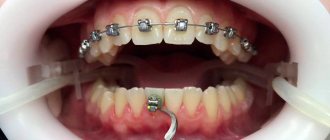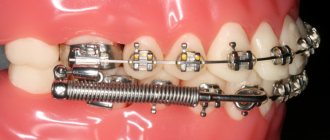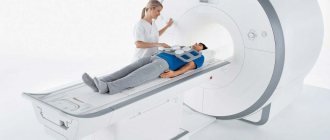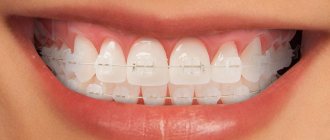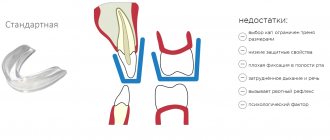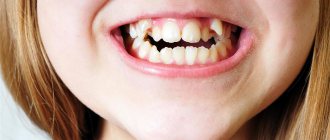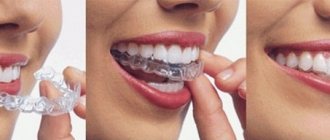Braces are orthodontic structures that help correct malocclusion and also correct uneven teeth. Most often, the bracket system is installed on the entire dental row between the molars. Is it possible to put a brace on 1 tooth or several? How long do partial braces last? Find out in the article.
In this article
- Types of bracket systems
- What dental problems can braces solve?
- How do braces work?
- Partial braces
- Indications for installing partial braces
- Necessary steps before installing partial braces
- Procedure for installing partial braces
- 2 by 4 braces system
- Braces for 4 teeth
- How long should you wear partial braces?
In modern dentistry, there are several different types of braces. If previously all structures were only metal and attached exclusively to the front surface of the teeth, which violated the aesthetics of the smile, now the choice is much wider. Systems are made from different materials in configurations to choose from. Which corrective structure to install depends on the individual characteristics of the patient’s dental system and his budget.
Types of bracket systems
Today the following systems of four types of materials are used:
- Metal. The most common and affordable, and also the most durable. But there are also nuances: if we talk about aesthetics, then metal braces are not the most advantageous option, and some people are allergic to the presence of metal in the mouth.
- Plastic. This type of braces is also quite inexpensive, but they are less durable than stainless steel. An important nuance - plastic structures are quickly stained by coffee, tea, cigarettes, acquiring a yellowish tint. It is better not to choose them for lovers of these drinks or smokers.
- Ceramic. Such designs are selected exactly to match the color of the enamel, so they look aesthetically pleasing and do not spoil the smile, and the ceramics are very durable. But one of the disadvantages of ceramic braces is their high cost.
- Sapphire. They are made from artificially grown sapphire crystals and are recognized as the most beautiful. Single crystals are transparent and invisible on the teeth; moreover, they can be easily cut and given any desired shape. But this type of structure is also quite expensive.
- Lingual braces can be made from any of the listed materials. This is the name of the system that is attached to the inside of the teeth and is invisible to the eyes of others. Such braces are often used when installed on the front incisors while maintaining the aesthetics of the dentition.
Most often, metal dental braces are chosen for correction due to their reasonable cost and practicality. However, in some cases, for example, with the same allergies, it is necessary to consider another type of orthodontic structures.
Installation Features
When installing in primary school or adolescence, the orthodontist is faced with the fact that it is inconvenient to work with a small oral cavity, so you need to have certain skills to make the correct fixation.
Before the start of treatment, the patient undergoes professional teeth cleaning to remove hard and soft deposits. For fixation, use one of the following methods:
- Direct method. The lock is glued to a predetermined place on the tooth where pressure should be applied.
- Indirect method. At the first stage, a plaster model is made, onto which the locks are super-precisely fixed in the right places. After this, the model is filled with a special material made of elastic plastic, resulting in a blank mouth guard. Transfer to the teeth occurs using this tray.
Installation of the classic system usually takes about an hour for one jaw. First, the teeth are dried, then the locks are attached using a special dental adhesive. Then the excess adhesive solution is removed, and an arc is inserted into the grooves on the locks, which will be the source of pressure for the system. Before starting, the child should be told how the process will go. It is necessary to explain that there will be no pain or discomfort.
What dental problems can braces solve?
Correction systems allow you to solve several dental problems at once:
- correct malocclusion;
- prevent the displacement of teeth adjacent to the removed one;
- align abnormally growing permanent teeth;
- cope with some congenital disorders of the upper and lower jaws.
Braces allow you to straighten crowded or, conversely, too sparsely spaced teeth. How does the structure work and how is the dental row corrected?
Contraindications
Among the absolute contraindications are the following:
- edentia with the absence of most of the dentition;
- malignant tumors in the facial part of the skull;
- serious diseases of the hematopoietic or cardiovascular system;
- immune system diseases;
- poor healing of bone tissue;
- endocrine disorders;
- mental illness;
- tuberculosis.
Relative contraindications are easier to eliminate:
- periodontal diseases;
- insufficient oral hygiene skills;
- pathologies of the temporomandibular apparatus;
- allergy to certain construction materials.
How do braces work?
All dental units are capable of changing their position - turning slightly around their own axis, tilting forward or backward. The corrective action of the braces system is based on this ability to move.
After a detailed examination of the dentition, during which the orthodontist determines the future trajectory of movement of each tooth, he installs braces on the teeth and connects them to each other, giving the fastening arch a certain degree of tension. She begins to put pressure on certain teeth, and they gradually change their position.
While wearing braces, the patient must make regular visits to the dentist, who, if necessary, will increase the degree of arch pressure or, conversely, weaken it.
Braces are usually installed on the entire row of teeth between the molars. But what if only one dental unit needs to be corrected? Is it possible to put braces on one tooth? Many people are often interested in this question: not everyone wants to wear the entire structure on the dentition due to a small correction. So is it possible to put braces on several teeth? Yes, put braces on the 2nd and 4th teeth that need correction, perhaps without affecting the rest.
How is the treatment carried out?
Correcting the bite and straightening the teeth –
a complex and lengthy process that takes place in several stages:
- Diagnosis – a comprehensive dental examination is necessary. First, it is necessary to determine the correction method. Secondly, you need to make sure that there are no contraindications to orthodontic treatment. The patient's dentofacial system must withstand the load associated with tooth movement. For this purpose, all existing carious lesions are sanitized and, if necessary, treatment of paro- and periodontal tissues is carried out.
- The preparatory stage is the actual planning of orthodontic treatment. Based on the data obtained during the examination, calculations are made of models of the patient’s dental system, as well as calculations of an orthopantomogram and teleroentgenogram of the head in a lateral projection, and based on this, a treatment plan is drawn up.
- Installation of braces. First, the surface of the teeth is prepared. For this purpose, professional oral hygiene is performed, the enamel is dried, etched, washed and dried again. Only after this, adhesive (glue) compounds are applied and braces are installed. To make the glue work, it is polymerized using a lamp. The process of installing braces is presented in the video.
- Installation of an orthodontic arch. The duration and complexity of this process will depend on the method of attaching the braces. Ligature systems require more painstaking work than the use of non-ligature braces.
- Next, the patient must periodically visit the dentist to activate the arch. As the teeth move, the originally set arch shape will become irrelevant, so it must be periodically changed to a new one. The duration of wearing one arch is determined by the position of the teeth and the age of the patient. In young people, treatment is faster.
- Removal of braces and retention period. Once the teeth are in the desired position, the braces are removed. However, this is not the end of treatment. The fact is that the teeth will tend to take their original position, and to prevent this it is necessary to use supporting structures called retainers. In some cases, retainers will need to be used for life, in others - for several months or years after the braces are removed.
Partial braces
Orthodontists use this type of construction in cases where it is necessary to correct deficiencies in only one of the jaws or at the initial stage of complex treatment. Partial braces are used for minor malocclusions caused by the misalignment of one or two teeth. The system is optimal when it is necessary to correct local tooth curvature in one area of the dental row.
This design is installed on only one jaw, and this is a very convenient solution: a partial braces system is significantly cheaper in cost than a full-fledged one, and it also does not create inconvenience when chewing food. But to use it, a number of conditions must be met.
Braces care
In order to clean your teeth and structures from dirt every day, you will have to purchase several special devices at once:
- An orthodontic toothbrush, thanks to its special shape and softer bristles, cleans teeth more thoroughly without the risk of the clasps coming off;
- small brushes, the heads of which are placed between the arch and the surface of the teeth;
- dental floss;
- a special toothpaste and rinse that inhibits the growth of bacteria in the oral cavity after brushing;
- irrigator, a special device that allows you to clean plaque from places where a brush and brushes cannot reach.
The child should be prepared to spend much more time than usual on hygienic cleaning. Especially if before that he did not use a toothbrush every day. The braces system increases the likelihood of developing caries, so you will have to take extra care of your teeth throughout the entire treatment period.
Indications for installing partial braces
To install braces on one or more teeth, certain indications are required, without which they cannot be attached purely technically:
- the diastema between the teeth should not be more than 3 mm wide;
- only one or more teeth should have a slight curvature, and the rest should close correctly;
- absence of problems with bite, including the important position of the molars relative to each other.
It must be understood that not all of the listed indications have. And even if you want to install partial braces, the doctor cannot do this due to non-compliance with the conditions. According to statistics, partial braces do not exceed 5% of the total number of corrective systems.
Adaptation stage
In almost all patients, after installing braces, the adaptation period occurs with severe or moderate discomfort. The child feels new elements in his mouth, and this is unusual. Sometimes there are tears and outbursts of aggression, but doctors will assure that most behavior at this stage depends on the reactions of the parents.
The feeling of pressure and aching in the jaw during correction with braces is understandable: the teeth gradually begin to move in the right direction. To reduce discomfort, a thin-section arc is first used, which creates light pressure. To ensure that adaptation goes as smoothly as possible, there are certain rules:
- There is no need to constantly touch the structure with your tongue and lips, although you will definitely have such a desire. These movements will cause irritation and chafing of the oral mucosa.
- You can buy dental wax at the pharmacy. It is applied to the locks or arch in the place where the mucous membrane is rubbed. You can use it around the clock for several days, and then the delicate tissues in these places will thicken on their own, and the irritation will go away. There is no need to remove wax while eating: it is inert and is not absorbed by the body, so getting into the digestive system is not dangerous.
- On the first day after installation, many parents allow the student to skip classes. Doctors believe that this is not necessary, since at school the child is distracted and is not so focused on new sensations.
- During the first days, the food should be soft, as problems with biting may occur. Later, the skill of biting will be developed, but biting off hard food should be avoided throughout the entire course.
- The patient should be weaned from sleeping face down, as this increases the pressure of braces on the inside of the lips. Position on the side or back is acceptable.
- If the pain is strong in the first day or two, you can take a painkiller. It is better not to use dental ointments and freezing gels.
- To eliminate severe pain, you cannot remove the arch - this will stop the process of adaptation and the entire treatment.
- If you notice that a particular hook is rubbing very strongly, you should consult your doctor. He will be able to press the protruding element more firmly to relieve the patient of discomfort.
Adaptation to braces in childhood is faster than in adults, but sometimes it can be more stormy: with tears, hysterics and scandals. Adults must diplomatically and clearly explain why correction is needed and what it will do. In a week or two, as a rule, adaptation is completed.
Necessary steps before installing partial braces
Before installing braces, the patient must undergo several procedures, based on the results of which the doctor will be able to make a full assessment of the condition of the dental row:
- visual inspection;
- manual diagnostics;
- taking an impression of the jaw;
- computed tomography of the jaw;
- selection of the optimal braces design, taking into account the structure of the dentition and the patient’s budget.
After these preparatory stages have been completed, the specialist proceeds to installing partial braces.
Rules of care and hygiene
To prevent treatment with braces from causing new dental problems in a child, certain rules should be followed:
- Use a brush marked “Soft” or a special orthodontic brush with a V-shaped cut in the bristles. This shape allows for efficient cleaning.
- The doctor should recommend a special paste containing minerals to strengthen the enamel.
- Using a brush in the evening, remove stuck pieces of food and plaque from under the arc.
- Super-floss on special plastic holders to clean out plaque using the thin waxed part and areas with fluffy thread.
- A mono-beam brush is used to clean the interdental joints.
- You can purchase an irrigator to effectively remove plaque between teeth and in the folds of gum tissue.
- Cleaning is carried out twice a day. If the child cannot do this carefully, an adult helps him.
- After each meal, the mouth should be rinsed with water and then with a special rinse. This will prevent the development of bacteria and inflammation.
Parents should monitor hygiene processes, especially for younger schoolchildren, who may be negligent in brushing their teeth.
Procedure for installing partial braces
Based on the data obtained from photographs of the dental row, the orthodontist begins their installation. They are attached as follows: micro-locks are glued to the teeth, and then an arch is attached to them with a certain tension. It is she who puts pressure on the teeth, helping them take the correct position. Installing braces on several teeth (2 or more) is completely painless and does not cause discomfort to the patient.
Many people are interested in whether it is possible to put braces on one tooth. Dentists answer that this is impossible, because braces are a specific system that requires at least four teeth to attach.
Lingual braces and diction
Installing an invisible braces system is the best option in terms of aesthetics. However, many patients complain that after installing lingual braces, their diction deteriorates. When correcting a bite with lingual braces, the patient may actually develop speech defects during the process of getting used to the device, especially when pronouncing sibilant consonants. For braces that are placed from the inside, this is a normal phenomenon; it completely disappears after two to four weeks, after which the patient continues to lead his usual lifestyle.
2 by 4 braces system
This is the name of a common method of attaching braces for the treatment of mixed dentition in children: the orthodontic system is installed on 2 molars and 4 incisors (hence the name). The recommended age for a child to have braces installed is 8-10 years. Braces can be placed on the upper or lower jaw, or on both at once.
Indications for installing a partial 2 by 4 bracket system:
- one or a pair of teeth growing incorrectly, causing discomfort to the child;
- too large interdental gap (often happens in children between the front incisors);
- lack of space for erupting teeth;
- early removal of baby teeth - this can later lead to malocclusion.
Installing partial braces will not help completely correct the bite, since all permanent teeth have not erupted. The 2 by 4 system is often a preparatory stage before wearing a full brace system. Considering that the enamel of children's teeth at this age is not yet strong, it is not recommended to install a partial system for a long time. In addition, children are usually not very careful about dental hygiene without proper supervision, and insufficient care of braces can lead to complications, such as caries.
After the permanent lateral teeth erupt, the partial bracket system is removed, and to maintain the result, the doctor installs a retainer - a special orthodontic splint that controls the position of the permanent teeth.
Excessive eruption of lateral teeth in the absence of antagonists in the opposite row
If one or two upper molars for any reason lack antagonists in the lower jaw, they will erupt until they reach contact. Therefore, before starting prosthetics in the lower row, it is necessary to return the excessively protruded upper teeth to the correct position in order to obtain a place that is currently missing for prosthetics.
In such situations, not only braces are used, but also microimplants, which in this case serve as temporary additional support. The treatment is carried out only on the upper jaw and requires high skill. You can insert a tooth no more than 2–3 mm, and for this you will need to accurately calculate the magnitudes and directions of all forces acting on it.
How long should you wear partial braces?
In adults, the period of use of partial corrective structures ranges from 6 months to 10 months; for a child, it can last for two years until all permanent teeth appear. For the effectiveness of treatment and timely adjustments when wearing partial braces, it is necessary to visit the orthodontist once a month. If you ignore this rule, you may end up not getting the effect of wearing braces: money and time will be wasted.
Before installing partial braces, the condition of the teeth and gums must be in perfect order: all dental diseases have been cured and hygienic cleaning has been carried out. Any braces systems are installed only in a healthy oral cavity.
Psychological preparation of the child
Not every parent can afford orthodontic treatment using sapphire or lingual braces. Yes, this is not always necessary. In addition to the fact that vestibular braces look unsightly, it is necessary to remember that the teeth hurt for the first time after installation, the structure is difficult to clean, and it is even difficult to eat with it. The right attitude helps a teenager cope with discomfort, find ways to turn design flaws into a reason for self-expression (choose colors and color combinations of ligatures, for example).
It is important to respect the child’s opinion and take into account his interests. You should not hush up possible problems associated with everyday wearing of the device, so that later the difficulties do not become an unpleasant surprise for the young patient and cause a decrease in motivation to continue treatment. Carrying out bite correction should be the decision of the child, and not the adults around him, since this is a complex and quite uncomfortable matter.
At the age of 12, not many children think about the need to correct their bite. It is necessary to develop in them an understanding of the importance of the beauty of a smile in interpersonal communication, an understanding of the relationship between the state of the oral cavity and the general state of human health. Well, the most important thing. Even before installing the system, it is necessary to take care of acquiring purely practical skills in caring for the structure. It will be much easier for a young patient to brush his teeth and braces with them if he has already formed the habit of using zuna floss, an irrigator, and mouth rinse.
Parents can teach their child by example by mastering the correct method of brushing teeth and using it regularly. All family members will benefit from this. Also, the time a child wears braces can be used to change the diet of all members. An orthodontic patient cannot eat solid food, so any chips and crackers are prohibited. Sticky and viscous products will take a long time to clean out from the spaces between the enamel and the arc. Changing the diet will allow you to avoid situations where the child feels deprived and switch to eating more healthy foods.
